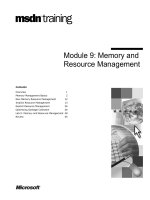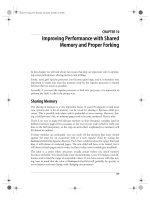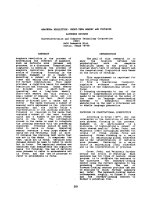Expanding Memory and I-O
Bạn đang xem bản rút gọn của tài liệu. Xem và tải ngay bản đầy đủ của tài liệu tại đây (898.03 KB, 33 trang )
h t t p : / / r e s o u r c e . r e n e s a s . c o m Page 161
Chapter 13
Expanding Memory and I/O
Since the H8/3048 has a 128kbyte internal ROM and an 8kbyte
internal RAM, it can accommodate a relatively large program without
externally expanding the memory. If the internal memory is insufficient,
however, you can externally expand it, which is essential for hardware design
engineers to know. Although software engineers can still develop programs
without this knowledge, they are also expected to understand some of the basic
techniques.
Although the H8/3048 can accommodate a dynamic RAM, this
chapter focuses on the basic functions and describes the ROM and static RAM.
In this chapter, you learn about which signals are required for expanding the
memory, how they change at reading/writing and how to calculate if the CPU
and memory speed match. This chapter also helps you understand memory
signals and timings.
Note: The following are negative logic signals:
Although the H8/3048 has an internal ROM and RAM, external memory
expansion may be required due to insufficient capacity. The following
describes how to connect the memory and CPU and match their speeds using
EPROM and SRAM as examples.
13.1 H8/3048 Operating Mode
When expanding the H8/3048 memory, you can determine how much
memory capacity to be added and how to use the data bus. The mode set pins
(MD0, MD1 and MD2) are used to select one of seven operating modes, which
determine the uses of the address bus, data bus and read/write signals.
Table 13.1 shows each mode:
* Status at resetting. It is available as either an 8- or 16-bit bus according
to the setting.
Since mode 7 represents single-chip mode, no external memory can be added.
h t t p : / / r e s o u r c e . r e n e s a s . c o m Page 162
Table 13.1: H8/3048 Operating Mode
The internal ROM and RAM are always connected to the CPU through
the 16-bit data bus irrespective of the mode setting. "Disabled" in the "Internal
ROM" column means that the internal ROM, though it exists, is disabled by
being disconnected from the CPU. In this case, an external ROM must be
connected. When the internal ROM and RAM are enabled, no external memory
can be added to the same address. If the same address is used, the internal
memory has priority, disabling reading/writing from/to the externally
connected memory.
13.2 Pins for Memory Connection
Table 13.2 shows the pins relating to memory connection provided for
the H8/3048 and their functions.
Connected memory size
Since there are 24 address buses (A0 to A23), up to 16Mbytes of
memory can be connected. If the memory to be connected is 1Mbyte or
smaller, only 20 address buses (A0 to A19) are required and the remaining 4
pins can be used for other purposes.
Data bus width
Since the H8/300H is a 16-bit CPU, it has 16 pins (D0 to D15) for
reading and writing 16-bit data. If word data is allowed to be divided into two
by the MOV.W instruction, only 8 data bus pins (D8 to D15) are required and
the remaining 8 pins (D0 to D7) can be used for other purposes.
As described above, the use of pins determines whether the memory
address is 16M or 1M and the data bus is either 16 or 8 bits. So you have to
figure out the most effective use with the limited number of pins.
h t t p : / / r e s o u r c e . r e n e s a s . c o m Page 163
Table 13.2: Pins Relating to Memory Connection
Address strobe
Indicates that an address is valid and that it is external when it is at low
level. It is not set at low level if an address is internal (internal ROM or RAM).
When the CPU is reading or writing data from/to the internal ROM or RAM,
reading/writing is not available externally. The RD, HWR and LWR signals
are not changed to low level, either.
Read/write signals
When the data bus width is 8 bits (RD and HWR are used):
Data buses D8 to D15 are used, and D0 to D7 are not.
h t t p : / / r e s o u r c e . r e n e s a s . c o m Page 164
When the data bus width is 16 bits (RD, HWR and LWR are used):
The RD signal is used as the read signal for both 8- and 16-bit widths,
the HWR signal is used for writing to an even-numbered address, and the LWR
signal is used for writing to an odd-numbered address. During 16-bit data
writing, both the HWR and LWR signals are output. For details, refer to the
section describing connection between the CPU and memory.
[Explanation with motion pictures and sound]
13.3 Read Timing from External Memory
Figure 13.1 shows the read timing from an external memory. This is an
example for 24-bit address and 16-bit data buses. Reading is completed in a 3-
system clock time (3-state access).
To read data or instructions from the memory, the setup time and hold time of
the read data must be satisfied.
h t t p : / / r e s o u r c e . r e n e s a s . c o m Page 165
Figure 13.1: Read Timing from External Memory
13.4 Write Timing to External Memory
Figure 13.2 shows the write timing to an external memory. This is an
example for 24-bit address and 16-bit data buses.
Writing is completed in a 3-system clock time (3-state access).
Figure 13.2: Write Timing to External Memory
h t t p : / / r e s o u r c e . r e n e s a s . c o m Page 166
Figure 13.3 shows the read/write timings including waits. If the WAIT
input is at low level at the trailing edge of T2, the CPU inserts a wait state to
slow reading/writing. When the WAIT input is returned to high level,
reading/writing is completed.
Depending on the address output by the CPU, users have to design
circuits to input WAIT signals if the memory connected to the address is slow,
or to prevent WAIT signals from being input if it is fast.
The H8/3048 is provided with a wait state controller so that the wait state can
be input without creating such circuits.
Figure 13.3: Read/Write Timings Including Waits
Since the H8/3048 has an internal wait controller, waits can be inserted
in various ways.
Wait state controller enable register (WCER)
Determines for which area the wait state controller is enabled from area
0 to area 7.
WCER H'FFFFEF address
h t t p : / / r e s o u r c e . r e n e s a s . c o m Page 167
Figure 13.4: Wait State Controller Enable Register (WCER)
The wait state controller is enabled for the area with "1" written and
disabled for that with "0". By default, it is enabled for all areas.
Wait control register
Determines how to insert waits for the wait-enabled area.
WCR H'FFFFEE address
Figure 13.5: Wait Control Register (WCR)
Wait mode select 1 and01 (WMS1 and WMS0)
Programmable wait mode
Without using the WAIT pin, forcibly inserts the wait set by the wait
count.
Pin wait mode 1
Waits for the wait cycle specified by the program and inserts an
additional wait depending on the WAIT pin status (Figure 13.3).
Pin auto wait mode
The WAIT signal input to the WAIT pin only determines whether to
insert a wait state or not, and how many states to be inserted is determined by
the wait count. Wait is inserted as necessary.
Wait count 1 and01 (WC1 and WC0)
h t t p : / / r e s o u r c e . r e n e s a s . c o m Page 168
This determines how many wait states to be inserted in a programmable
wait or pin auto wait mode.
By default, the wait controller is enabled for all areas and three states
are set to be inserted in programmable wait mode. In other words, three wait
states are forcibly inserted in all areas. Change the setting as soon as possible
after resetting if necessary.
13.5 Sample Memory (EPROM)
The HN27C4001G is used here as an EPROM example.
The HN27C4001G has a 4Mbit capacity and 524288 word × 8 bit
configuration. Figure 13.6 shows the pin assignment.
Figure 13.6: NH27C4001G Pin Assignment Diagram
There are 19 address input pins, A0 to A18.Since addresses are input in
19-bit units, this memory has 512-kbyte (to be more precise, 524,288)
addresses. The address count of the memory IC is determined by the address
pin count.
There are 8 data pins, I/O0 to I/O7, meaning that the memory uses 8
bits per address. Since this is a ROM, it is a read only memory when connected
to a CPU and the data pins are set to output. They are changed to input pins for
writing by an EPROM writer. Here, we consider the case in which it is
connected to a CPU and serves as a ROM only.
The Vpp pin is designed to apply the write voltage (12V) for writing by
an EPROM writer. It is fixed to high or low level for operation as a ROM with
connection to a CPU.
h t t p : / / r e s o u r c e . r e n e s a s . c o m Page 169
CE (Chip Enable) is a memory select signal and the memory is selected
when it is set at low level. This is used to assign a specific address by adding
an address-decoded signal.
OE (Output Enable) is an output enable signal and read data is output
from a data pin when it is set at low level.
The table below summarizes this.
In read mode, the CPU reads data from the EPROM and sets both CE
and OE at low level.
In output disable mode, the memory is selected but read data is not
output to an I/O pin. The I/O pin is set in high impedance mode (disconnected
state).
In standby mode, the memory is not selected. When CE is set at high
level, the system is set in standby mode irrespective of the OE setting. Since
the memory IC is not operating in this mode, power consumption is low.
Table 13.3 shows the HN27C4001G read timing. There are 100ns and
120ns types.
Table 13.3: HN27C4001G Read Timing
Read timing waveform
Figure 13.7 shows the HN27C4001G read timing.
Read data is output from an I/O pin when the access time (t
ACC
), CE output
delay time (t
CE
) and OE output delay time (t
OE
) are satisfied.
h t t p : / / r e s o u r c e . r e n e s a s . c o m Page 170
Figure 13.7: Read Timing Waveform
13.6 Sample Memory (SRAM)
The HM628512BI is used here as a static RAM example. It has a 4Mbit
memory capacity and 524288 word × 8 bit configuration. Figure 13.8 shows
the pin assignment.
Figure 13.8: HN628512BI Pin Assignment
There are 19 address pins, using 512 kbytes, and 8 data pins, using 8
bits per address.
h t t p : / / r e s o u r c e . r e n e s a s . c o m Page 171
CS (Chip Select) is a memory select signal and is the same as CE of the
EPROM. The memory is selected when it is set at low level. This is used to
assign a specific address by adding an address-decoded signal.
OE (Output Enable) is an output enable signal and read data is output
from a data pin when it is set at low level. The function and name are the same
as for OE of the EPROM.
Writing is enabled when WE (Write Enable) is set at low level. Table
13.4 summarizes this.
Table 13.4: HM628512BI Modes
In read mode, the CPU reads data from the SRAM and sets both CS and
OE at low level.
In output disable mode, the memory is selected but read data is not
output to an I/O pin. The I/O pin is set in high impedance mode (disconnected
state).
Write operation takes two forms. When CS is set at low to set WE at
low, OE is capable of writing at either high or low. Writing with OE set at high
is called the "OE clock" mode since it is set at low for reading and high for
writing. Writing with OE set at low, on the other hand, is called the "OE low
fixed" mode since it is set at low for both reading and writing. Writing is
generally conducted in OE clock mode.
In non-selection mode, the memory is not selected. When CS is set at
high, the system is set in non-selection mode irrespective of the OE or WE
setting. Since the memory IC is not operating in this mode, power consumption
is low.
Table 13.5 shows the HM628512BI read cycle. There are 70ns and 80ns types.
Table 13.5: HM628512BI Read Cycle
h t t p : / / r e s o u r c e . r e n e s a s . c o m Page 172
Read cycle timing
Figure 13.7 shows the read timing waveform. Read data is output to an
I/O pin when the address access time (t
AA
), chip select access time (t
CO
) and
output enable access time (t
OE
) are satisfied.
Figure 13.9: Read Timing Waveform
Table 13.6 shows the HM628512BI write cycle.
Table 13.6: HM628512BI Write Cycle
Figure 13.10 shows the write cycle waveform of the OE clock.
The important parameters for the write timing are input data set time
(t
DW
) and input data hold time (t
DH
).
Writing is conducted at either the CS or WE leading edge, whichever is
earlier. The input data set time (t
DW
) and input data hold time (t
DH
) must be
satisfied for this write timing.
h t t p : / / r e s o u r c e . r e n e s a s . c o m Page 173
Figure 13.10: Write Cycle Waveform (OE Clock)
13.7 Connecting CPU to Memory
(Connecting EPROM Using 8-bit
Data Bus)
The following conditions are assumed here for connecting a CPU to a
memory:
CPU: H8/3048F (clock frequency: 10MHz)
16Mbyte memory space (24 address pins)
Internal ROM disabled (internal ROM is not used but an
EPROM is connected externally)
8-bit data bus (D8 to D15 used)
RD, HWR and CS0 to CS7 are used as control signals
Memory: HN27C4001G-10 for EPROM (access time: 100ns)
HM628512BI-8 for SRAM (access time: 85ns)
First, let's consider how to connect a CPU to a memory using an 8-bit data bus.
Address assignment
What should be determined first is to which addresses the memory is to
be connected.
As described in "Exception Handling", a program operating based on
resetting and the reset vector must be located in a ROM. Since the reset vector
is between H'000000 and H'00003, a ROM must be connected to starting from
the H'000000 address if only one ROM is connected.
In internal ROM enable mode, the internal ROM addresses are from
H'000000 to H'01FFFF. In internal ROM disable mode, the HN27C4001G









